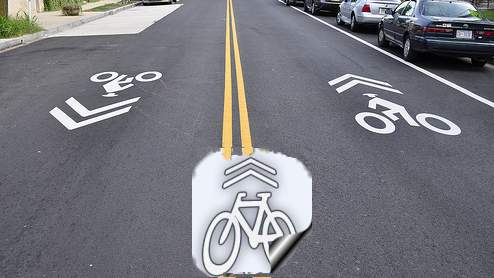
Since the mid-2000’s, sharrows — a chevron-and-bike logo painted on a road lane indicating that the lane must be shared by cars and bicycles — have become familiar markings on urban American roads. Unbeknownst to people other than activists and city officials, their existence is planned for as part of road maintenance work. Most of us will discover them by chance. Only night owls can catch a glimpse of city crews stenciling such markings, hastily, onto either decrepit or newly paved roads, under the glow of glaring street lights.
Although they symbolize a battle for acceptance and changing times, sharrows are simply paint on a road. Best case scenario: they may be a placeholder for bigger changes ahead. Worst case scenario: they may be an excuse to avoid permanence.
Paint is cheap. It is cheaper than widening roads. It is cheaper than installing barriers between cars and bicycles. It draws attention when it’s new, and conveniently fades into oblivion when its novelty has worn off. So it should be no wonder that paint was chosen as the agent of road use change.
The paint itself changed nothing. No one has to steer to avoid anything. Nothing alters the layout of the road. There is only a message about what already existed — a reminder of uncommonly known laws about who can use the roads.
Ever since sharrows hit the scene, cyclists have been debating them. This debate revolves around the half-empty or half-full glass dichotomy. Pessimists, who see the glass as half-empty, hold that the sharrows are worthless. Only true bike lanes, separated from cars, will suffice for them. Optimists, who see the glass as half-full, regard sharrows as a start, a harbinger of better things to come. By taking small steps initially, they expect to achieve greater change in the future.
Drivers care much less about sharrows because, from their perspective, they are nothing more than a reminder to watch for bicycles. Unless the drivers are also avid cyclists, sharrows represent a reasonable compromise. The roads remain as they were, and cyclists have been appeased by having their presence marked on the roads.
New symbols can be debated. Meaning can be read into them since what they stand for hasn’t yet been agreed upon. Meaning, in this case, is in the eye of the beholder. Our proof for this is that none of the major American dictionaries have added “sharrow” as a word meaning “shared lane marking.”
With respect to sharrows — symbols of lane sharing — there is a connotation of protection for bicycles created by depicting a bicycle moving in a forward direction on a reserved spot. This is not much different from security officers parting a crowd to make way for a celebrity and entourage when they’re trying to move through a sea of people where there is no clear path. It is an arbitrary and transient path, full of displacement and ambiguity.
Even though sharrows create a place for bicycles, they provide no physical protection for cyclists. Yet, despite being an amorphous, undelineated bicycle lane, a row of sharrows can offer some protection for cyclists, albeit in an abstract way.
A sharrow is not a bicycle lane; it’s a right. In that sense, it offers protections to cyclists which they may not be aware of. For instance, when sharrows are present, and a motorist opens a car door into the path of a bicycle, the sharrows strengthen the cyclists case against the motorist.
A bicycle symbol painted on the road predicts the possible appearance of a bicycle. It serves as a reminder to drivers that there are bicycles in the vicinity. The same holds true for most situations where a car and bicycle have a conflict.
If a driver cuts off a bicycle, or strikes a bicyclist who has the right of way, he or she cannot use the argument that they didn’t expect to see a bicycle on the road — that it caught them by surprise. When pictures of bicycles are plastered all over the roads, no driver can be surprised by seeing an actual bicycle. He should, in fact, be looking for the bicycles that go along with the painted symbols.
While it would be nice to have physical protection on the roads, increasing one’s legal protection on those roads is not nothing. Avoiding injury would be best. But if a cyclist does get injured, she has a better chance of collecting payment for her medical bills and bicycle repair or replacement costs on roads where the presence of bicycles is well marked.
Whether residing in the half-full or half-empty glass camp, cyclists can rejoice in the knowledge that sharrows strengthen cyclists’ rights. They may not offer the kind of accommodations cyclists would like to see, but they lay the groundwork for holding drivers accountable for their actions towards cyclists.
Next time a cyclist is inclined to compare sharrows with a real bike lane, which offers a buffer between him and cars, he should remember: sharrows are road paint parading as protection.



